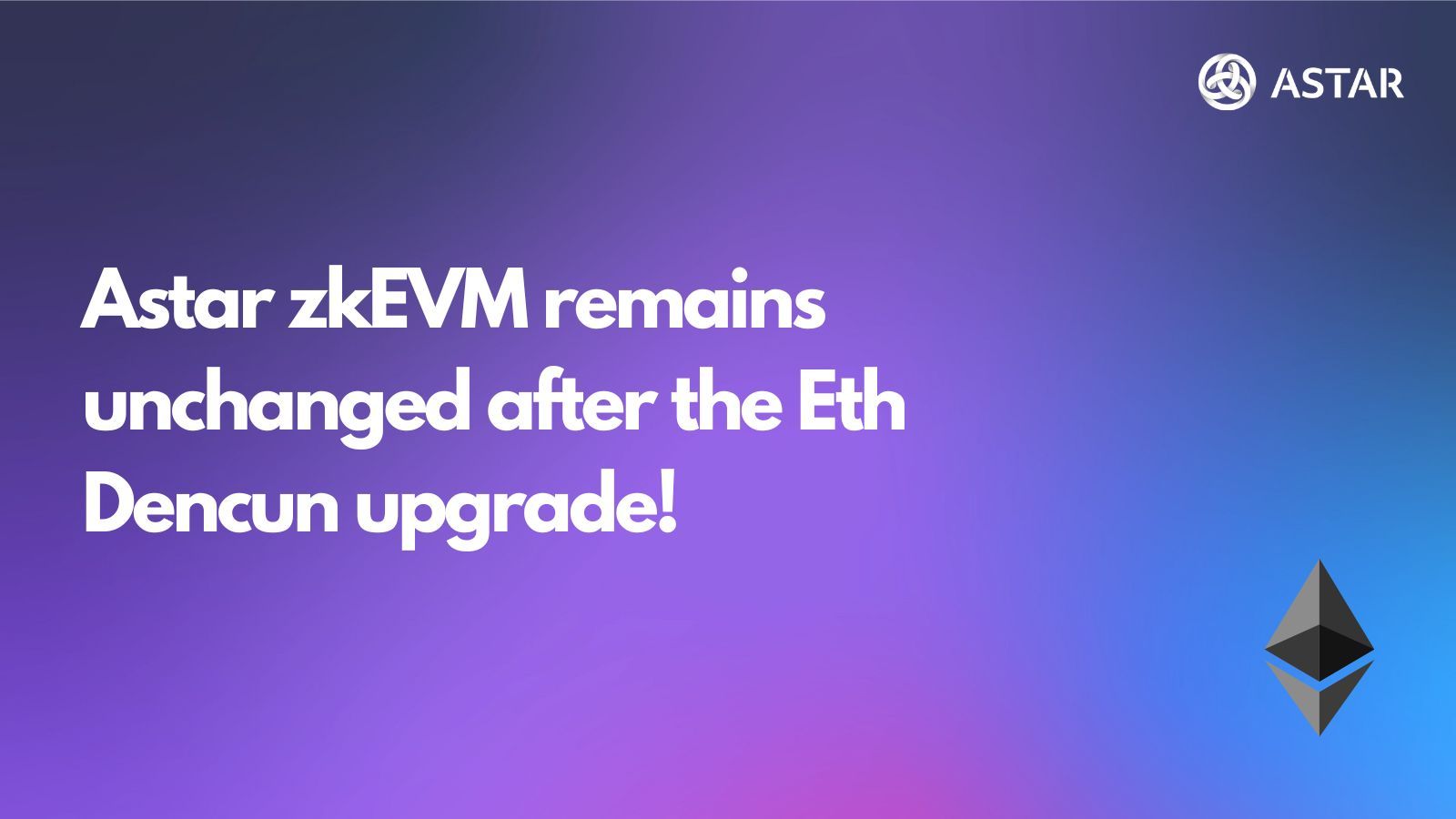Table of Contents
TL;DR:
- EIP-4844 introduces blobspace, a data storage solution for Ethereum to efficiently manage L2 transaction data (via Blobs).
- Data blobs will reduce transaction costs for Ethereum rollups because they don’t require permanent storage on Ethereum, making them cheaper per byte.
- Astar zkEVM is built with the Polygon CDK in Validium mode. The transaction fees are already low because the transaction data is not stored on Ethereum.
On March 14, the Dencun upgrade will go live on Ethereum Mainnet. Dencun includes six EIPs related to Ethereum’s execution logic. The most important among these is EIP-4844, which introduces a special resource exclusively for Layer 2’s that will reduce transaction fees.
Beyond EIP-4844, Dencun is set to bring several other improvements, including some aimed at tidying things up on the opcode side, as well as improvements to staking, validating, and communication between the two layers. Those other improvements are:
- EIP-4788 – improving communication between Ethereum’s consensus and execution layers
- EIP-6780 and EIP-5656 – fixing problematic opcodes
- EIP-7044 and EIP-7045 – for improved staking and validator experience
These are some of the new features coming to Ethereum due to the Dencun upgrade. We also have EIP-1153, set to introduce opcodes for ‘transient storage’ that are expected to reduce costs further and improve efficiency.
🚨 Exactly how much EIP-4844 will reduce transaction fees is unknown, but current estimates are from 2x - 5x.
Now, what are blobs?
Blobspace is a storage management concept often used in database systems to efficiently store and manage large objects, such as binary large objects (BLOBs). In the context of data availability on Ethereum, blobspace is the counterpart to the concept of blockspace, as a representation of blobs capacity.
Blobs is a low-cost alternative to calldata, the current data storage resource for Rollups. Both calldata and blobs are forms of persistent memory. However, whereas calldata needs to be stored permanently as a part of Ethereum transaction, blobs are stored for around 18 days. This provides enough time for nodes to ensure that transaction data is available in the event of a liveness issue while also removing the storage burden that calldata imposes on the network.
One important difference between calldata and blobs is that calldata can be used in the exact amount in which it is needed. Blobs, on the other hand, have to be bought whole (128KB per blob) and can’t be shared between L2s.
So, blobs in general will be cheaper than calldata when there are enough transactions to fill the blob. In the case of some L2s, this means that there may be occasions in which it is cheaper to post transaction data as calldata.
Blobs pricing is similar to EIP-1559. The number of blobs that can be attached to a block ranges from 0 to 6, but 3 is the target. If blocks keep having more than the target 3 blobs, the price will continually increase. This means we can expect blobs price to go up when there is more demand from Rollup L2s in the future.
What can we expect from EIP-4844 (Proto-Danksharding)?
The Cancun-Deneb upgrade will not implement full Danksharding. EIP-4844 is often referred to as 'Proto-Danksharding', named after Ethereum researchers Protolambda and Dankrad Fiest. It serves as a preliminary version of Danksharding and will establish most of the cryptographic foundations necessary for its full implementation.
Once EIP-4844 is in place, the remaining work to implement Danksharding will be confined to the consensus layer. Afterward, there will be no further requirements for the execution layer teams or the rollups themselves to transition from Proto-Danksharding to Danksharding. Rollups will simply be provided with more and larger blobs to work with.
Astar zkEVM
Astar zkEVM is different with other L2s. It uses the Polygon CDK in a special mode called Validium, where the transaction fees are already cheaper. Yes, there are other L2s on Polygon CDK, but Astar zkEVM is the pioneer as the first L2 connected to the AggLayer.
Now, with the new improvement upgrade, including EIP-4844, Ethereum will be cheaper to use, especially for certain projects called rollups. Rollups help Ethereum handle more transactions at once. EIP-4844 does this by making it cheaper to store data on Ethereum and by using Blobs.
Even with this new upgrade, Astar zkEVM has a trick up its sleeve to keep costs even lower. It uses outside help (like DAC or third-party solutions) to manage its transaction data. This means it doesn't have to store all its data directly on Ethereum, which can get expensive even with blobs. Instead, it can choose the cheapest way to store data, whether on Ethereum or elsewhere. With the power of zk-technology, everything will still operate in a fully trustless environment.
This is really good for two reasons:
- It saves money: By choosing where to store data wisely, Astar zkEVM can keep transaction costs low for everyone using it. Making Astar zkEVM future-proof.
- It's flexible: Astar zkEVM can easily adapt to new changes or improvements in technology without being stuck with one way of doing things.
In simple terms, Astar zkEVM benefits from being modular and can always adopt the best option, saving transaction costs for the users while still getting what it needs. This makes it a strong option for people looking for cheaper and more efficient ways to use Ethereum, even as new improvements like EIP-4844 come into play.

